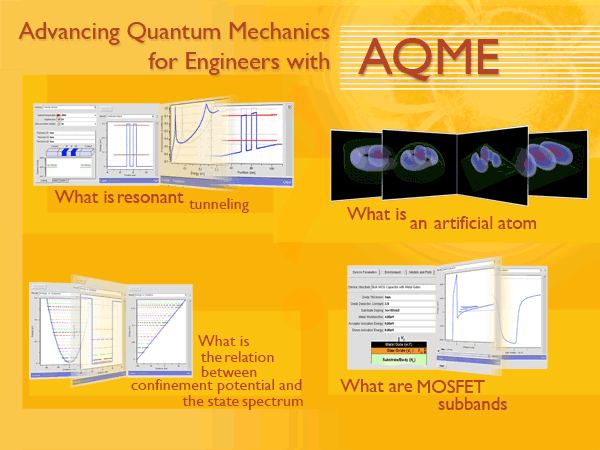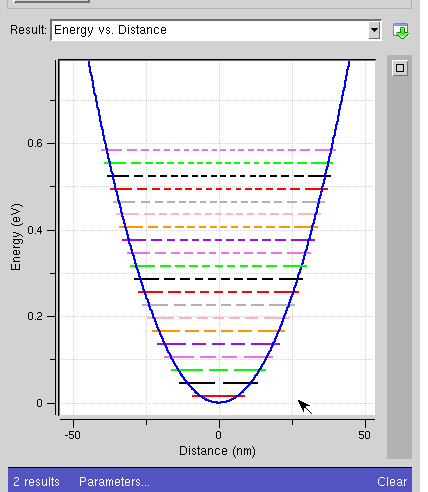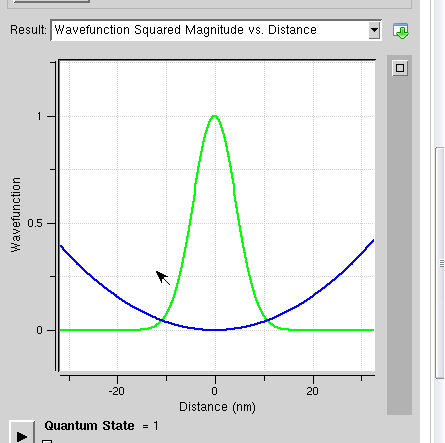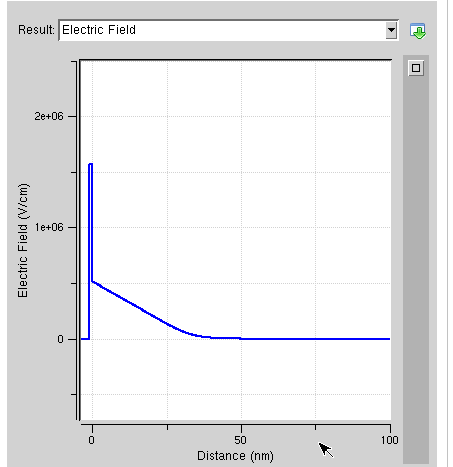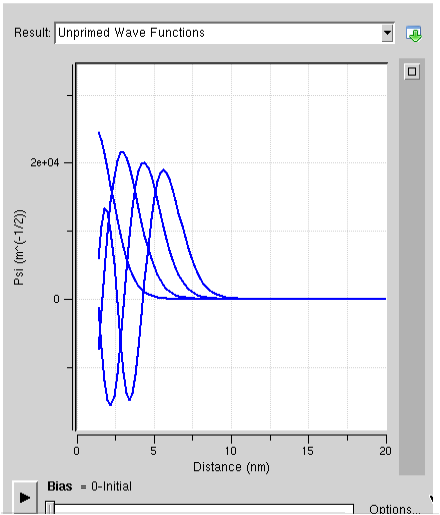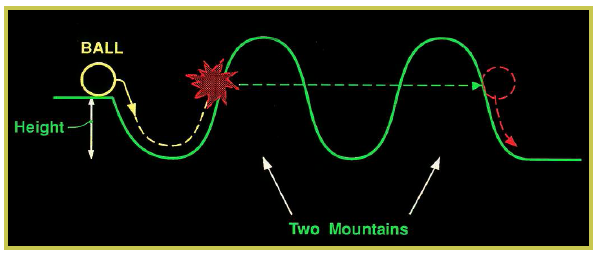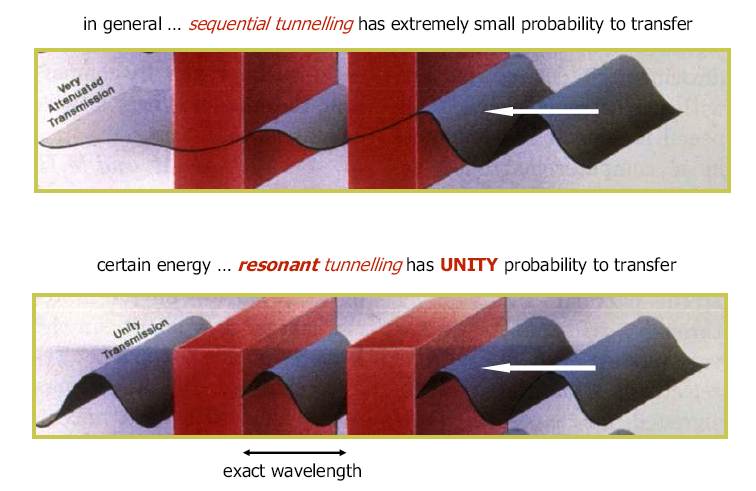AQME – Advanced Quantum Mechanics for Engineers
Introduction to Quantum Mechanics for Physicists and Engineers with AQME Nanotechnology has yielded a number of unique structures that are not found anywhere in nature. Most demonstrate an essential quality of Quantum Mechanics known as quantum confinement. The idea behind confinement is all about keeping electrons trapped in a small area. The sizes we’re talking about here for confinement have to be less than 30 nm for effective confinement. Quantum confinement comes in several flavors. 2-D confinement is only restricted in one dimension, and the result is a quantum well (or plane). These are what most lasers are currently built from. 1-D confinement occurs in nanowires. 0-D confinement is found only in the quantum dot.
One is probably wondering why confinement is so important. For one thing, it leads to new electronic properties that are not present in today’s semiconductor devices. Consider the quantum dot. The typical quantum dot is anywhere between 3-60 nm in diameter. That’s still 30 to 600 times the size of a typical atom. A quantum dot exhibits 0-D confinement, meaning that electrons are confined in all three dimensions. The only things in nature that have 0-D confinement are atoms. So a quantum dot can be loosely described as an ‘artificial atom’. This is vitally important because we can’t readily experiment on regular atoms. They’re too small and too difficult to isolate in an experiment. Quantum dots, on the other hand, are large enough to be manipulated by magnetic fields and can even be moved around with an STM or AFM. We can deduce many important atomistic characteristics from a quantum dot that would otherwise be impossible to research in an atom.
Confinement also increases the efficiency of today’s electronics. The laser is based on a 2-D confinement layer that is usually created with some form of epitaxy like Molecular Beam Epitaxy or Chemical Vapor Deposition. The bulk of modern lasers created with this method are highly functional, but ultimately inefficient in terms of energy consumption and heat dissipation. Moving to 1-D confinement in wires or 0-D confinement in quantum dots allows for higher efficiencies and brighter lasers. Quantum dot lasers are currently the best lasers available though their fabrication is still being worked out. Confinement is just one manifestation of quantum mechanics in nanodevices. Tunneling and quantum interference are the other two manifestations of quantum mechanics in the operation of, for example, scanning tunneling microscopes and resonant tunneling diodes, respectively.
Because of the importance of understanding quantum mechanics to understand the operation of nanoscale devices, almost every Electrical Engineering department in which there is a strong nanotechnology experimental or theoretical group and all Physics departments teach the fundamental principles of quantum mechanics and its application to nanodevice research. Within these courses one is first introduced to the concept of particle-wave duality (the photoelectric effect and the double-slit experiment), the solutions of the time-independent Schrodinger equation for open systems (piece-wise constant potentials), tunneling and bound states. The description of the solution of the Schrodinger equation for periodic potentials (Kronig-Penney model) naturally follows from the discussion of double well, triple well and n-well structures. This leads the students to the concept of energy bands and energy gaps and the concept of the effective mass that can be extracted from the precalculated bandstructure by fitting the curvature of the bands. The Tsu-Esaki formula is then derived so that having calculated the transmission coefficient one can calculate the tunneling current in resonant tunneling diode and Esaki diode. After establishing basic principles of quantum mechanics, the harmonic oscillator problem is then discussed in conjunction with understanding vibrations of a crystalline lattice and the concept of phonons is introduced as well as the concept of creation and annihilation operators. The typical quantum mechanics class for undergraduate/first year graduate students is then completed with the discussion of the stationary and time dependent perturbation theory and the derivation of the Fermi Golden Rule which is used as a starting point of a graduate level class in semiclassical transport. Yet another issue that is discussed sometimes in a typical quantum mechanics class is the concept of Coulomb Blockade.
AQME assembles a set of nanoHUB tools that we believe are of immediate interest for the teaching of quantum mechanics class for both Engineers and Physicists. Users no longer have to search the nanoHUB to find the appropriate applications for this particular purpose. This curated page provides a “on-stop-shop” access to associated materials such as homework or project assignments. We invite you to participate in this open source, interactive educational initiative:
- Contribute your content by uploading it to the nanoHUB. (See “Contribute Content”) on the nanoHUB mainpage. If you tag your contribution with “AQME” we will easily associate your contribution to this tool and may include it into this curated page.
- Provide feedback for the items you use on the nanoHUB through the review system. (Please be explicit and provide constructive feedback.)
- Let us know when things do not work for you – file a ticket through the nanoHUB “Help” feature on every page
- Finally, let us know what you are doing and your suggestions improving the nanoHUB by using the “Feedback” section, which you can find under “Support”
Thank you for using the nanoHUB, and be sure to share your nanoHUB success stories with us. We like to hear from you, and our sponsors need to know that the nanoHUB is having impact.
Particle-Wave Duality
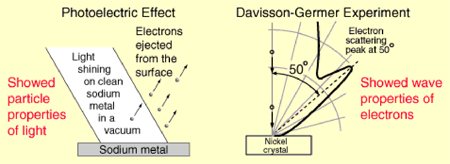 Publicized early in the debate about whether light was composed of particles or waves, a wave-particle dual nature soon was found to be characteristic of electrons as well. The evidence for the description of light as waves was well established at the turn of the century when the photoelectric effect introduced firm evidence of a particle nature as well. On the other hand, the particle properties of electrons was well documented when the DeBroglie hypothesis and the subsequent experiments by Davisson and Germer established the wave nature of the electron.
Publicized early in the debate about whether light was composed of particles or waves, a wave-particle dual nature soon was found to be characteristic of electrons as well. The evidence for the description of light as waves was well established at the turn of the century when the photoelectric effect introduced firm evidence of a particle nature as well. On the other hand, the particle properties of electrons was well documented when the DeBroglie hypothesis and the subsequent experiments by Davisson and Germer established the wave nature of the electron.
Particle-Wave Duality: an Animation
This movie helps students to better grasp the concept when nano-things behave as particles and when they behave as waves.
Exercises:
Solution of the Time-Independent Schrodinger Equation
Piece-Wise Constant Potential Barrier Tool – Open Systems
The Piece-Wise Constant Potential Barriers Tool allows calculation of the transmission and the reflection coefficient of arbitrary five, seven, nine, eleven and 2n-segment piece-wise constant potential energy profile. For the case of multi-well structure it also calculates the quasi-bound states so it can be used as a simple demonstration tool for the formation of energy bands. Also, it can be used in the case of stationary perturbation theory exercises to test the validity of, for example, the first order and the second order correction to the ground state energy of the system due to small perturbations of, for example, the confining potential. The Piece-Wise Constant Potential Barriers Tool tool can also be used to test the validity of the WKB approximation for triangular potential barriers.
Exercises:
- More on the energy bands formation: Cosine bands
Bound States Lab
The Bound States Calculation Lab Calculation Lab determines the bound states and the corresponding wavefunctions in a square, harmonic and triangular potential well. Maximum number of eigenstates that can be calculated is 100. Students clearly see the nature of the separation of the states in these three prototypical confining potentials with which we can approximate realistic quantum potentials that occur in nature.
Energy eigenstates of a harmonic oscillator (left panel). Probability density of the ground state that demonstrates purely quantum-mechanical behavior (middle panel). Probability density of the 20th subband where we start to see more classical behavior (right panel) as the well opens.
Exercises:
Energy Bands and Effective Masses
Periodic Potential Lab
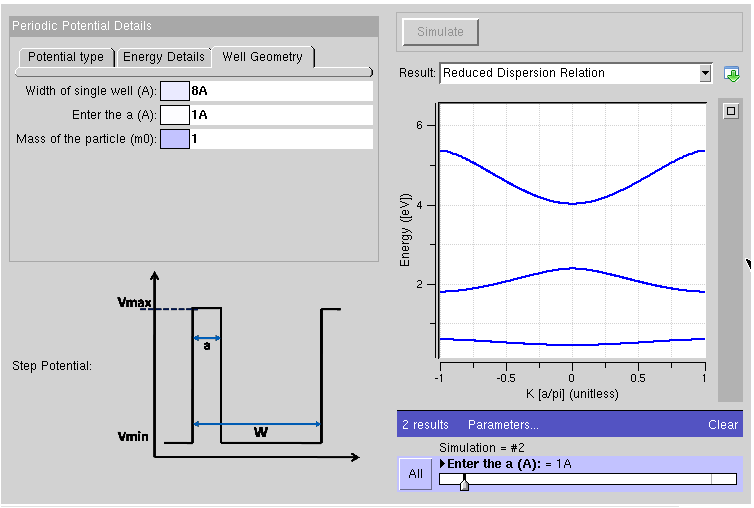
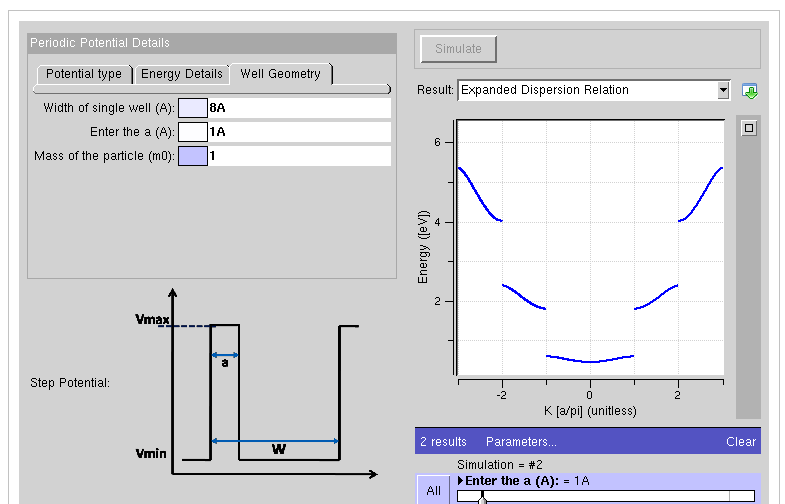 The Periodic Potential Lab solves the time independent Schroedinger Equation in a 1-D spatial potential variation. Rectangular, triangular, parabolic (harmonic), and Coulomb potential confinements can be considered. The user can determine energetic and spatial details of the potential profiles, compute the allowed and forbidden bands, plot the bands in a compact and an expanded zone, and compare the results against a simple effective mass parabolic band. Transmission is also calculated. This Lab also allows the students to become familiar with the reduced zone and expanded zone representation of the dispersion relation (E-k relation for carriers).
The Periodic Potential Lab solves the time independent Schroedinger Equation in a 1-D spatial potential variation. Rectangular, triangular, parabolic (harmonic), and Coulomb potential confinements can be considered. The user can determine energetic and spatial details of the potential profiles, compute the allowed and forbidden bands, plot the bands in a compact and an expanded zone, and compare the results against a simple effective mass parabolic band. Transmission is also calculated. This Lab also allows the students to become familiar with the reduced zone and expanded zone representation of the dispersion relation (E-k relation for carriers).
Exercises:
Bandstructure Lab
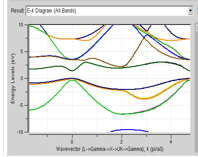
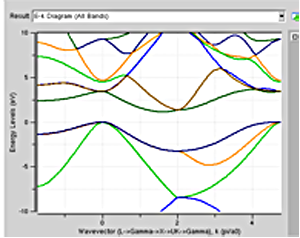 Bandstructure of Si (left panel) and GaAs (right panel).
Bandstructure of Si (left panel) and GaAs (right panel).
In solid-state physics, the electronic band structure (or simply band structure) of a solid describes ranges of energy that an electron is “forbidden” or “allowed” to have. It is due to the diffraction of the quantum mechanical electron waves in the periodic crystal lattice. The band structure of a material determines several characteristics, in particular its electronic and optical properties. The Band Structure Lab tool enables the study of bulk dispersion relationships of Si, GaAs, InAs. Plotting the full dispersion relation of different materials, students first get familiar with a band-structure of direct band-gap (GaAs, InAs) and indirect band-gap semiconductors (Si). For the case of multiple conduction band valleys one has to determine first the Miller indices of one of the equivalent valleys and from that information it immediately follows how many equivalent conduction bands one has in Si and Ge, for example. In advanced applications, the users can apply tensile and compressive strain and observe the variation in the bandstructure, bandgaps, and effective masses. Advanced users can also study bandstructure effects in ultra-scaled (thin body) quantum wells, and nanowires of different cross sections. Bandstructure Lab uses the sp3s*d5 tight binding method to compute E(k) for bulk, planar, and nanowire semiconductors.
Exercises:
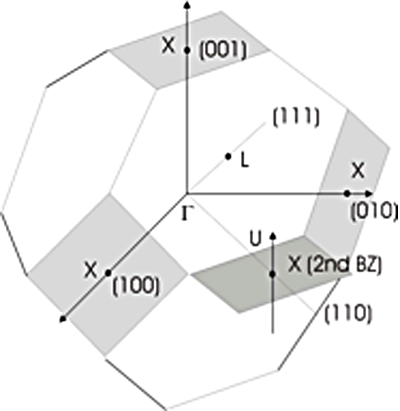 First Brillouin zone of FCC lattice that corresponds to the first Brillouin zone for all diamond and Zinc-blende materials (C, Si, Ge, GaAs, InAs, CdTe, etc.). There are 8 hexagonal faces (normal to 111) and 6 square faces (normal to 100 ). The sides of each hexagon and square are equal.
First Brillouin zone of FCC lattice that corresponds to the first Brillouin zone for all diamond and Zinc-blende materials (C, Si, Ge, GaAs, InAs, CdTe, etc.). There are 8 hexagonal faces (normal to 111) and 6 square faces (normal to 100 ). The sides of each hexagon and square are equal.
Supplemental Information: Specification of High-symmetry points
| Symbol | Description |
| Γ | Center of the Brillouin zone |
| Simple Cube | |
| M | Center of an edge |
| R | Corner Point |
| X | Center of a face |
| Face-Centered cubic | |
| K | Middle of an edge joining two hexagonal faces |
| L | Center of a hexagonal face |
| U | Middle of an edge joining a hexagonal and a square face |
| W | Corner point |
| X | Center of a square face |
| Body-Centered Cubic | |
| H | Corner point joining four edges |
| N | Center of a face |
| P | Corner point joining three edges |
| Hexagonal | |
| A | Center of a hexagonal face |
| H | Corner POint |
| K | Middle of an edge joining two rectangular faces |
| L | Middle of an edge joining a hexagonal and a rectangular face |
| M | Center of a rectangular face |
Real World Applications
Schred
Schred calculates the envelope wavefunctions and the corresponding bound-state energies in a typical MOS (Metal-Oxide-Semiconductor) or SOS (Semiconductor-Oxide- Semiconductor) structure and a typical SOI structure by solving self-consistently the one-dimensional (1D) Poisson equation and the 1D Schrodinger equation. The Schred tool is specifically designed for Si/SiO2 interface and takes into account the mass anisotropy of the conduction bands as well as different crystallographic orientations.
Exercises:
 Right panel – Potential diagram for inversion of p-type semiconductor. In this first notation Εij refers to the j-th subband from either the Δ2-band (i=1) or Δ4-band (i=2). Left panel – Constant-energy surfaces for the conduction-band of silicon showing six conduction-band valleys in the < 100> direction of momentum space. The band minima, corresponding to the centers of the ellipsoids, are 85% of the way to the Brillouin-zone boundaries. The long axis of an ellipsoid corresponds to the longitudinal effective mass of the electrons in silicon, , while the short axes correspond to the transverse effective mass, . For < 100> orientation of the surface, the Δ2-band has the longitudinal mass (ml) perpendicular to the semiconductor interface and the Δ4-band has the transverse mass (mt) perpendicular to the interface. Since larger mass leads to smaller kinetic term in the Schrodinger equation, the unprimed lader of subbands (as is usually called), corresponding to the Δ2-band, has the lowest ground state energy. The degeneracy of the unprimed ladder of subbands for < 100> orientation of the surface is 2. For the same reason, the ground state of the primed ladder of subbands corresponding to the Δ4-band is higher that the lowest subband of the unprimed ladder of subbands, The degeneracy of the primed ladder of subbands for (100) orientation of the interface is 4.
Right panel – Potential diagram for inversion of p-type semiconductor. In this first notation Εij refers to the j-th subband from either the Δ2-band (i=1) or Δ4-band (i=2). Left panel – Constant-energy surfaces for the conduction-band of silicon showing six conduction-band valleys in the < 100> direction of momentum space. The band minima, corresponding to the centers of the ellipsoids, are 85% of the way to the Brillouin-zone boundaries. The long axis of an ellipsoid corresponds to the longitudinal effective mass of the electrons in silicon, , while the short axes correspond to the transverse effective mass, . For < 100> orientation of the surface, the Δ2-band has the longitudinal mass (ml) perpendicular to the semiconductor interface and the Δ4-band has the transverse mass (mt) perpendicular to the interface. Since larger mass leads to smaller kinetic term in the Schrodinger equation, the unprimed lader of subbands (as is usually called), corresponding to the Δ2-band, has the lowest ground state energy. The degeneracy of the unprimed ladder of subbands for < 100> orientation of the surface is 2. For the same reason, the ground state of the primed ladder of subbands corresponding to the Δ4-band is higher that the lowest subband of the unprimed ladder of subbands, The degeneracy of the primed ladder of subbands for (100) orientation of the interface is 4.
1D Heterostructure Tool
The 1D Heterostructure Tool simulates confined states in 1D heterostructures by calculating charge self-consistently in the confined states, based on a quantum mechanical description of the one dimensional device. The greater interest in HEMT devices is motivated by the limits that will be reached with scaling of conventional transistors. The 1D Heterostructure Tool in that respect is a very valuable tool for the design of HEMT devices as one can determine, for example, the position and the magnitude of the delta-doped layer, the thickness of the barrier and the spacer layer for which one maximizes the amount of free carriers in the channel which, in turn, leads to larger drive current. This is clearly illustrated in the examples below.
Exercises:
- Uniform vs. delta-doped heterostructure. What is better?
- Parallel conduction channels in heterostructures.
The most commonly used semiconductor devices for applications in the GHz range now are GaAs based MESFETs, HEMTs and HBTs. Although MESFETs are the cheapest devices because they can be realized with bulk material, i.e. without epitaxially grown layers, HEMTs and HBTs are promising devices for the near future. The advantage of HEMTs and HBTs is a factor of 2 to 3 higher power density compared to MESFETs which leads to significantly smaller chip size.
HEMTs are field effect transistors where the current flow between two ohmic contacts, Source and Drain, and it is controlled by a third contact, the Gate. Most often the Gate is a Schottky contact. In contrast to ion implanted MESFETs, HEMTs are based on epitaxially grown layers with different band gaps Eg. A schematic cross section of a HEMT is shown below.
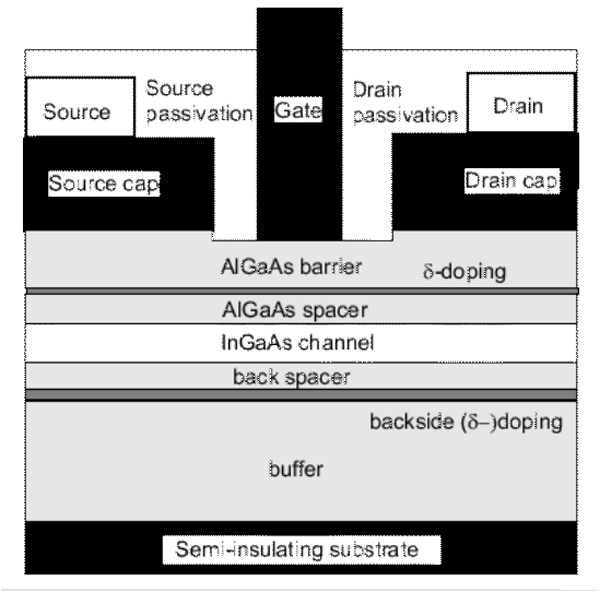 Schematic cross section of a High Electron Mobility Transistor (HEMT).
Schematic cross section of a High Electron Mobility Transistor (HEMT).
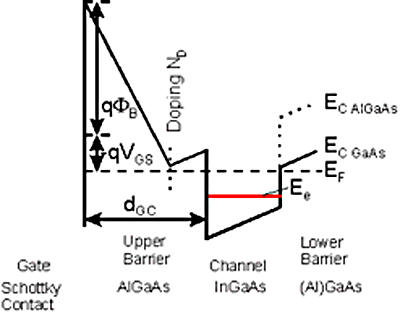 If two semiconductors with different band gap energies are joined together, the difference is divided up into a band gap offset in the valence band ΔEV and a band gap offset in the conduction band ΔEC. One of the most common assumptions made for the AlGaAs/InGaAs material system is 40% valence band offset and 60% conduction band offset. This is only valid for Al contents below about 45%. For higher Al contents the bandgap of AlGaAs changes from direct to indirect. In the figure below such an AlGaAs/InGaAs HEMT with a delta doped upper barrier layer is shown. The conduction band energy under the gate along the cutting line A-A’ is shown to the right.
If two semiconductors with different band gap energies are joined together, the difference is divided up into a band gap offset in the valence band ΔEV and a band gap offset in the conduction band ΔEC. One of the most common assumptions made for the AlGaAs/InGaAs material system is 40% valence band offset and 60% conduction band offset. This is only valid for Al contents below about 45%. For higher Al contents the bandgap of AlGaAs changes from direct to indirect. In the figure below such an AlGaAs/InGaAs HEMT with a delta doped upper barrier layer is shown. The conduction band energy under the gate along the cutting line A-A’ is shown to the right.
Resonant Tunneling Diode Lab
Put a potential barrier in the path of electrons, and it will block their flow. But if the barrier is thin enough, electrons can tunnel right through due to quantum mechanical effects. Even more surprising, if two or more thin barriers are placed closely together, electrons will bounce between the barriers, and at certain resonant energies, flow right through the barriers as if they were not there! Check out the Resonant Tunneling Diode Simulator lab, which lets you control the number of barriers and their material properties, and then simulate current as a function of bias. Devices exhibit a surprising negative differential resistance, even at room temperature! Run this tool online, right in your web browser! View a demo of this tool in action.
Exercises:
A resonant tunnel diode (RTD) is a device which uses quantum effects to produce negative differential resistance (NDR). As an RTD is capable of generating a terahertz wave at room temperature, it can be used in ultra high-speed circuitry. Therefore The RTD is extensively studied. RTDs are formed as a single quantum well structure surrounded by very thin layer barriers. This structure is called a double barrier structure. Carriers such as electrons and holes can only have discrete energy values inside the quantum well. When a voltage is placed across an RTD, a terahertz wave is emitted which is why the energy value inside the quantum well is equal to that of the emitter side. As voltage increased, the terahertz stops because the energy value in the quantum well is outside the emitter side energy. This structure can be grown by molecular beam heteroepitaxy. GaAs and AlAs in particular are used to form this structure. AlAs/InGaAs or InAlAs/InGaAs can be used.
Quantum Dots Lab
Individual quantum dots can be created from two-dimensional electron or hole gases present in remotely doped quantum wells or semiconductor heterostructures. The sample surface is coated with a thin layer of resist. A lateral pattern is then defined in the resist by electron beam lithography. This pattern can then be transferred to the electron or hole gas by etching, or by depositing metal electrodes (lift-off process) that allow the application of external voltages between the electron gas and the electrodes. Such quantum dots are mainly of interest for experiments and applications involving electron or hole transport, i.e., an electrical current. The energy spectrum of a quantum dot can be engineered by controlling the geometrical size, shape, and the strength of the confinement potential. Also in contrast to atoms it is relatively easy to connect quantum dots by tunnel barriers to conducting leads, which allows the application of the techniques of tunneling spectroscopy for their investigation. Confinement in quantum dots can also arise from electrostatic potentials (generated by external electrodes, doping, strain, or impurities).
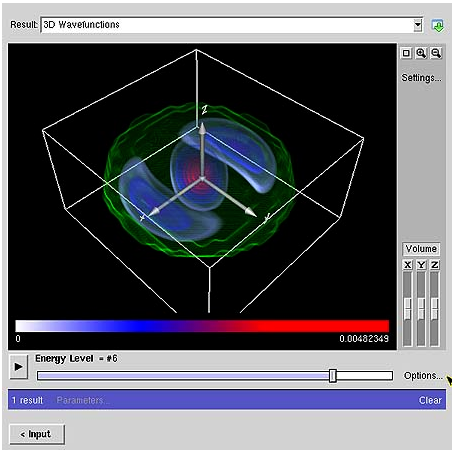 Quantum Dot Lab computes the eigenstates of a particle in a box of various shapes including domes and pyramids.
Quantum Dot Lab computes the eigenstates of a particle in a box of various shapes including domes and pyramids.
One can explore the world of quantum dots with the Quantum Dot Lab which computes the eigenstates in quantum dots of various shapes including domes and pyramids.
Exercises:
Scattering and Fermi’s Golden Rule
Scattering is a general physical process whereby some forms of radiation, such as light, sound or moving particles, for example, are forced to deviate from a straight trajectory by one or more localized non-uniformities in the medium through which they pass. In conventional use, this also includes deviation of reflected radiation from the angle predicted by the law of reflection. Reflections that undergo scattering are often called diffuse reflections and unscattered reflections are called specular (mirror-like) reflections. The types of non-uniformities that can cause scattering, sometimes known as scatterers or scattering centers, are too numerous to list, but a small sample includes particles, bubbles, droplets, density fluctuations in fluids, defects in crystalline solids, surface roughness, cells in organisms, and textile fibers in clothing. The effects of such features on the path of almost any type of propagating wave or moving particle can be described in the framework of scattering theory. In quantum physics, Fermi’s golden rule is a way to calculate the transition rate (probability of transition per unit time) from one energy eigenstate of a quantum system into a continuum of energy eigenstates, due to a perturbation. The Bulk Monte Carlo Labcalculates the scattering rates dependence versus electron energy of the most important scattering mechanisms for the most commonly used materials in the semiconductor industry such as Si, Ge, GaAs, InSb, GaN, SiC. For proper parameter set for, for example, 4H SiC please refer to the following article.
Exercises:
- Scattering rates for Si
- Scattering rates for GaAs
- Scattering rates for 4H SiC
Coulomb Blockade
In physics, a Coulomb blockade, named after Charles-Augustin de Coulomb, is the increased resistance at small bias voltages of an electronic device comprising at least one low-capacitance tunnel junction. According to the laws of classical electrodynamics, no current can flow through an insulating barrier. According to the laws of quantum mechanics, however, there is a nonvanishing (larger than zero) probability for an electron on one side of the barrier to reach the other side. When a bias voltage is applied, this means that there will be a current flow. In first-order approximation, that is, neglecting additional effects, the tunnelling current will be proportional to the bias voltage. In electrical terms, the tunnel junction behaves as a resistor with a constant resistance, also known as an ohmic resistor. The resistance depends exponentially on the barrier thickness. Typical barrier thicknesses are on the order of one to several nanometers. An arrangement of two conductors with an insulating layer in between not only has a resistance, but also a finite capacitance. The insulator is also called dielectric in this context, the tunnel junction behaves as a capacitor.
The [Resource{2925)] allows simulation of non-linear current-voltage (I-V) characteristics through single and double quantum dots and as such illustrates various single electron transport phenomena.
Exercises:
- Coulomb blockade design exercises that uses Quantum Dot Lab
